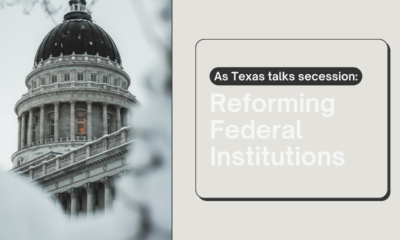Executive
Texas, the cold, and bad planning
Texas is suffering from the cold, bad federal policies, and worse internal planning. Texas has good reason to seek independence but must plan for it.

The Great Polar Vortex of 2021 brought freezing and sub-freezing temperatures to most of the country. (And in fact the Vortex still exists; another winter storm will strike Thursday.) And as everyone is talking about, it hit Texas the hardest. As of this posting, fifteen people have died in Texas from the weather. They either froze to death or poisoned themselves with carbon monoxide through desperate measures to heat their homes. Millions of people still lack power, running water, or both. Some on the political left have replied with a sick and sick-making display of schadenfreude. People on both sides of the Great Renewables Debate have weighed in, each with a distorted version of the facts. The facts demand better planning on the part of the Texas grid operator and all power generators. This holds especially as Texas considers whether to secede from the Union.
Where Texas now stands
Texas uniquely has its own power grid, separate and apart from the two major grids or “interconnections” that serve the rest of the Contiguous States. (For you Alaskans, this means “The Lower Forty-eight.”) The Texas Interconnection serves 85 percent of the State. (The Western Interconnection serves El Paso County, and the Eastern serves East Texas and the northwestern part of the Panhandle.) So as regards power generation and distribution, what happens in Texas stays in Texas. Furthermore, nothing outside of Texas can affect Texas. Which normally works out well for the largest electric generator and consumer. But it requires Texas to plan ahead for emergencies.
The Electric Reliability Council of Texas (ERCOT) manages the State’s unique electrical grid. The events of this last weekend have prompted the Governor to demand an explanation. ERCOT exists to keep the lights on. They didn’t do it. Why couldn’t they do it? That question has many different answers, and the truth will spare no one, as Dan Bongino says below.
The Reserve Margin
ERCOT maintains a Reserve Margin of generating capacity upon which it can call at a moment’s notice to address generating failures or spiking demand. But this margin consists of energy generating capacity, not energy storage. At year’s end, this reserve margin stood at 15.5 percent. But according to this same Capacity, Demand and Reserve report, ERCOT was counting on home and “utility-scale” solar farms to build this reserve. (To say nothing of the 20 percent of total generating capacity from the wind turbines of West Texas.)
CNAV will not say that wind and solar are useless in the cold. But: they failed this time because no one required their builder-operators to plan for an extreme-cold emergency. This fault plagued all generating modes, some worse than others.
Even worse than that: much of that reserve margin consisted of natural gas. ERCOT apparently has to ask federal permission to turn on extra generating capacity in advance of the ice storm. And the feds said NO. When the situation became as unacceptable as it was undeniable, the feds reversed themselves. Too little, too late.
We hear this from Dan Miller of the Texas Nationalist Movement. He cites this as a good reason to pass the Texas Independence Referendum Act and to vote Yes. For further information on this Act, see here.
Lack of winterization
But the fault does not lie entirely with federal environmental and power-management authorities. ERCOT must take its share of the blame, along with wind, natural gas, coal, and nuclear power generators.
Your editor lived in Texas for a total of eight and a half years, in two extended stays. And each time included one or two very cold winters. Contrary to popular belief—including faulty memories even among Texans—Texas does get cold in the winter, sometimes! When Arctic air invades from Canada, it often drives due south. The Rocky Mountains to the west, and the Appalachian Mountains to the east, confine the cold air. The confinement gets tighter as one travels further south, by reason of how those two mountain chains line up. As a result, a “flying wedge” of cold air moves in across the Panhandle and at least as far south as Houston.
So why didn’t ERCOT ever require any of its generators to winterize? Winterizing costs money. True, but all safety measures cost money. Like insurance, they might not seem “necessary,” but they’re good to have. ERCOT had the responsibility for planning for the winter. And they didn’t plan for a winter like this.
Market distortion and short-range thinking
Remarkably, Erick-Woods Erickson, at least when he’s not saying that Trump supporters are crazy, sometimes talks sense. As he does in this piece. He explains that a lot of federal money poured into Texas, going back decades, to set up “renewable energy” generation. And whoever wrote the checks, didn’t require certain common-sense steps for winterizing. In fact, the wind and solar farms don’t even need to install batteries to store energy for when they can’t generate it.
Chuck DeVore explains it in this tweet and thread on Twitter:
DeVore says the solar and wind farms don’t need to purchase (or contract with) battery farms. Why not? Who made that decision? Battery-farm technology has improved greatly. Tesla made headlines by installing a very large battery farm in South Australia, with as much capacity as a peaker plant. Not only does this work better, but it costs less to run than the peaker plant did. That no one thought of this solution is bad enough. That no one required any backup is inexcusable.
The solar and wind generators can do more than that. They could and should coat wind-turbine blades with an ice-retardant shellac, and deploy drones to de-ice them at need. Tesla (again!) has developed a high-end solar roof tile that sheds snow easily. A vital consideration when collecting the sun’s rays in winter! If they have this available, why don’t the utility-scale generators use it?
Conventional plants in Texas also at fault
Don’t absolve the conventional generators, either. Natural gas, coal, and nuclear plants all failed, some to a worse extent than others. The reasons for this are as many and varied as the plants themselves. But they all come down to the same thing: they didn’t winterize.
Why not?
Texas and other states have no incentive to build baseload capacity because federal subsidies for renewables distort the market. Likewise, maintaining and weatherizing those baseload systems is economically disincentivized by those same federal subsidies. Additionally, most renewal energy systems have no obligations to contribute to maintenance of the existing power grid or ramp up capacity to that grid.
That federal authorities wrote those checks, and created an “unfunded mandate” in the process, could serve yet more to push Texans to vote to secede. Perhaps the ultimate problem is: the market for electricity generation is not free and never has been free. (And remember: the conventional generators didn’t get any of those checks.) But whatever the cause, Texas must find a solution before next winter.
Schadenfreude is fine, but…!
And then we hear from a Member of Congress who now has more power than sense. Representative Alexandria Ocasio-Cortez (D-N.Y.) says this:
What can she be talking about? Since Texas does derive significant “juice” (in good weather) from wind and solar, saying “this is what happens when you don’t have a Green New Deal” is oxymoronic. So is this next gem:
Evidently she hasn’t read the history. Nor does she propose any particular program to “help.”
Do Democratic Party members want to provoke a Texit War?!? That would seem to follow from attitudes like hers.
Where does Texas go from here?
Texas might do well to re-examine its relationship with the rest of the country. When then-President Sam Houston begged for nine years for the United States to annex Texas, it might have made sense. He might not have felt the same way, had he had a dream of hearing such oxymoronic victim-blaming from a Member of Congress.
In any case, votes of the Legislature and the people might result in the seating of a committee of Texas Senators and Representatives to consider how to change Texas law to protect Texas residents. (The Independence Referendum Act specifies such a Committee’s composition and mission if the people vote Yes.) So herewith a few suggestions:
- Eliminate all subsidies all around. If residential, commercial, or industrial customers want to generate their own power by sun and wind, let them decide. If anyone thinks they can provide grid-scale power from sun or wind, let them invest their own capital.
- Require, as part of any contract for long-term power generation, that the generator maintain and winterize his equipment. That Arctic Flying Wedge will return. Texas must be ready when it does.
- Extend the Texas Interconnection to El Paso, the rest of the Panhandle, and East Texas. Keep power lines in place at those and other locations, to bring in power from outside Texas in an emergency.
If “authority and responsibility must be equal,” then autonomy and self-responsibility also must be equal. That’s why people plan for emergencies.
Terry A. Hurlbut has been a student of politics, philosophy, and science for more than 35 years. He is a graduate of Yale College and has served as a physician-level laboratory administrator in a 250-bed community hospital. He also is a serious student of the Bible, is conversant in its two primary original languages, and has followed the creation-science movement closely since 1993.
-

 Civilization4 days ago
Civilization4 days agoTrump’s Venezuela Gamble and America’s Shifting National Security Strategy
-

 Civilization4 days ago
Civilization4 days agoOperation Absolute Resolve: Anatomy of a Modern Decapitation Strike
-

 Civilization3 days ago
Civilization3 days agoTen Reasons To Cheer the Arrest of Maduro
-

 Civilization5 days ago
Civilization5 days agoTrump delivers deeds, not words
-

 Civilization1 day ago
Civilization1 day agoOne Fell Swoop: Lawsuit Eyes Death Blow to Racial Preferences
-

 Civilization3 days ago
Civilization3 days agoTrump’s New Executive Order on Space Has the Right Stuff
-

 Executive2 days ago
Executive2 days agoWaste of the Day: $1.6T in Wasteful Spending in Rand Paul’s “Festivus” Report
-

 Guest Columns2 days ago
Guest Columns2 days agoAdvice to Democrats Regarding Maduro Arrest: Resist Reflexive Opposition













[…] 1359), an explosion of activity has taken place. The Texas Deep Freeze put the desirability of, and readiness of Texas for, independence in stark relief. But after that, Governor Greg Abbot (R-Texas) sent the Texas Rangers […]
[…] war game 3: expulsionsTexit war game 4 – hostilitiesTexit war game 5 – remember the Texas!Texas, the cold, and bad planningTexit – a real life updateTexit legislative and practical situationTexit – two bills to […]
[…] war game 3: expulsionsTexit war game 4 – hostilitiesTexit war game 5 – remember the Texas!Texas, the cold, and bad planningTexit – a real life updateTexit legislative and practical situationTexit – two bills to […]
[…] war game 3: expulsionsTexit war game 4 – hostilitiesTexit war game 5 – remember the Texas!Texas, the cold, and bad planningTexit – a real life updateTexit legislative and practical situationTexit – two bills to […]
[…] war game 3: expulsionsTexit war game 4 – hostilitiesTexit war game 5 – remember the Texas!Texas, the cold, and bad planningTexit – a real life updateTexit legislative and practical situationTexit – two bills to […]
[…] game 3: expulsions Texit war game 4 – hostilities Texit war game 5 – remember the Texas! Texas, the cold, and bad planning Texit – a real life update Texit legislative and practical situation Texit – two bills to […]
[…] Paying people to install heat pumps. Heat pumps, or reversible air conditioners, can heat a home or building more efficiently than making new heat on-site. But that applies mainly in the south, with its mild winters. (It does not apply in Texas, which is the target of the Arctic Flying Wedge.) […]